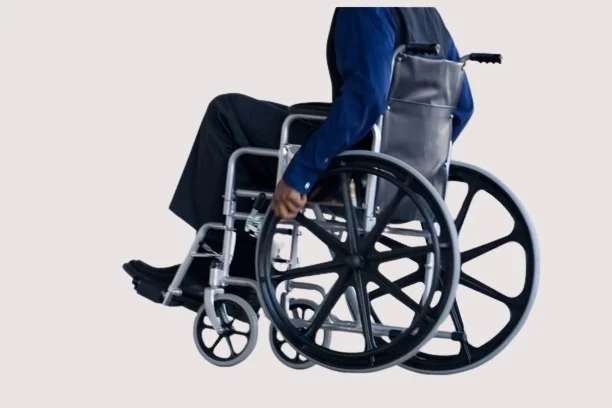Challenges as Wheelchair User: Tips & Solutions

Table of Contents
Challenges as Wheelchair User: Tips & Solutions
Wheeling Through Life: Navigating Challenges as a Wheelchair User
Imagine yourself zipping down the sidewalk on a sunny day. Suddenly, you hit a crack in the pavement, sending your wheels jarring upwards. This might be a minor inconvenience for most, but for wheelchair users, it’s a daily reality.
Navigating Challenges as a Wheelchair User isn’t just about physical barriers. It’s about navigating a world that wasn’t always built with accessibility in mind. But despite the challenges, wheelchair users are a vibrant and determined community.
This blog post dives into the common hurdles wheelchair users face, explores solutions and helpful tips, and highlights ways we can all work towards a more inclusive world.
Embracing Life on Wheels: It’s All About How You See It
Life can be an adventure, no matter how you navigate it. For wheelchair users, this adventure might involve overcoming some unique obstacles. But fear not, fellow explorers! This guide is here to equip you with the knowledge and strategies to conquer those challenges and live life to the fullest.
Wheelchair Accessibility: Building Bridges, Not Barriers
Imagine this: you’re excited to grab a coffee with a friend, but the entrance to the cafe has a steep step. This is a common scenario for wheelchair users, highlighting the importance of wheelchair accessibility.
Unfortunately, many public spaces lack features like ramps, wide doorways, and accessible restrooms. This can make even simple tasks frustrating. Thankfully, the conversation about accessibility challenges for disabilities is gaining momentum. Architects and designers increasingly incorporate features that make buildings and public spaces wheelchair accessible.
Here are some things you can do to advocate for wheelchair accessibility:
- Talk to your local representatives: Let them know how important accessibility is to you and your community.
- Support businesses that prioritize accessibility: Your patronage sends a powerful message.
- Spread awareness: Talk to friends, family, and colleagues about the importance of accessibility.
Common Barriers to Users of Wheelchairs
Beyond physical barriers, wheelchair users often encounter attitudinal barriers. Some people might stare at you or make assumptions about your capabilities. It’s important to remember that challenges wheelchair users face are not a reflection of their limitations but rather obstacles that can be overcome.
Here are some common barriers faced by wheelchair users:
- Physical Barriers: Uneven sidewalks, narrow doorways, and inaccessible public transportation can all pose challenges.
- Attitudinal Barriers: Negative stereotypes and a lack of awareness can create social awkwardness.
- Technological Challenges: Malfunctioning wheelchairs, limited battery life, and a lack of charging stations can be frustrating.
Problems Wheelchair Users Face at Home (and How to Fix Them!)
Believe it or not, your own home can sometimes present challenges. Problems wheelchair users face at home can range from inaccessible countertops to narrow doorways. The good news is that many of these issues can be addressed with modifications.
Here are some ideas to make your home more wheelchair accessible:
- Widen doorways: A little extra space can make a big difference.
- Install ramps: Ramps can help you navigate elevation changes.
- Lower countertops: This makes them easier to reach from a seated position.
- Invest in grab bars: These can provide extra support in bathrooms and other areas.
What People in Wheelchairs Need and What They Can Do: Redefining Limitations
Sometimes, people might wonder what people in wheelchairs need or what people in wheelchairs can do. The answer is simple: wheelchair users need the same things everyone else does – respect, inclusion, and the opportunity to live fulfilling lives.
People in wheelchairs are capable of achieving great things! They can be doctors, lawyers, athletes, artists – endless possibilities.
The Negative Effects of Being in a Wheelchair
It’s important to acknowledge that there can be negative effects of being in a wheelchair. Physical limitations, social isolation, and pain can all be challenges. However, focusing solely on the negatives can be discouraging.
The key is to reframe the narrative. Instead of dwelling on limitations, focus on your strengths and accomplishments. There are many challenges wheelchair users face, but there are also countless ways to overcome them.
Accessibility Challenges for Disabilities: We’re All in This Together
Accessibility challenges for disabilities are not just an issue for wheelchair users – they affect people with a variety of impairments. Working together can create a more inclusive and accessible world for everyone.
Here are some ways we can help wheelchair users:
- Offer assistance when needed: If you see someone struggling, politely offer a helping hand.
- Be patient and understanding: Navigating the world can be more challenging for wheelchair users.
- Educate yourself: Learn more about disability rights and accessibility.
Empowering Yourself: Resources and Tools for Wheelchair Users
Living life to the fullest as a wheelchair user requires having the right resources and tools at your disposal. Here are some helpful resources to keep bookmarked:
- National Center for Disability Rights (NCDH): National Center for Disability Rights National Center on Disability and Journalism – This organization fights for the rights of people with disabilities and provides valuable resources on topics like accessibility and advocacy.
- The Christopher & Dana Reeve Foundation: [Christopher and Dana Reeve Foundation paralysis ON christopherreeve.org] supports research on spinal cord injuries. It provides resources for people living with paralysis.
- The American Association of People with Disabilities (AAPD): [American Association of People with Disabilities aapd com ON aapd.com] – The AAPD is a leading voice for disability rights in the United States. Their website offers various topics, including employment, education, and healthcare.
- Wheelchair Travel: [AccessibleGO wheelchair travel ON wheelchairtraveling.com] – This website is a treasure trove of information for wheelchair travellers. It features reviews of accessible hotels, destinations, and transportation options.
Building a Supportive Community
There’s immense strength in connecting with others who understand the challenges and triumphs of using a wheelchair. Here are some ways to build a supportive community:
- Online forums and communities: Several online forums and communities cater specifically to wheelchair users. These platforms offer a safe space to share experiences, ask questions, and find encouragement.
- Disability rights organizations: Many disability rights organizations host events and social gatherings for people with disabilities. These events are a great way to meet new people and participate in the disability rights movement.
- Support groups: Support groups can be valuable for emotional support and practical advice. There are likely support groups for wheelchair users in your area.
Remember: You are not alone on this journey. A whole community is cheering you on and ready to offer support.
The Final Gear: Maintaining a Positive Mindset
Navigating challenges as a wheelchair user requires a healthy dose of optimism and resilience. Here are some tips for maintaining a positive mindset:
- Focus on your abilities: Don’t dwell on what you can’t do. Celebrate your strengths and accomplishments.
- Embrace your individuality: Your wheelchair is a part of what makes you unique. Own it with confidence!
- Find humor in the little things: Laughter is the best medicine. Don’t be afraid to laugh at yourself and the occasional awkward situation.
- Set and achieve goals: Setting and achieving goals is a great way to boost your confidence and self-esteem.
- Surround yourself with positive people: The people you spend time with can significantly impact your mood. Surround yourself with supportive and encouraging individuals.
FAQs Challenges Faced by Wheelchair Users
General
- What are some common challenges faced by wheelchair users?
- Physical barriers like uneven sidewalks, narrow doorways, and inaccessible transportation.
- Attitudinal barriers like stereotypes and a lack of awareness.
- Technological challenges like malfunctioning wheelchairs and limited battery life.
- What resources are available for wheelchair users?
- National Center for Disability Rights (NCDH)
- The Christopher & Dana Reeve Foundation
- The American Association of People with Disabilities (AAPD)
- Wheelchair Travel
- How can I build a supportive community as a wheelchair user?
- Online forums and communities
- Disability rights organizations
- Support groups
Daily Life
- How can I make my home more wheelchair accessible?
- Widen doorways
- Install ramps
- Lower countertops
- Invest in grab bars
- What should I do if I encounter an inaccessible public space?
- Advocate for accessibility by talking to your local representatives and supporting businesses prioritizing it.
Mindset
- How can I maintain a positive mindset as a wheelchair user? Focus on your abilities and celebrate your accomplishments.
- Embrace your individuality and find humor in the little things.
- Set and achieve goals to boost your confidence.
- Surround yourself with positive and supportive people.
Travel
- What are some things to consider when planning a trip as a wheelchair user?
- Research accessible hotels, destinations, and transportation options.
- Consider contacting the places you plan to visit beforehand to confirm accessibility features.
- Be prepared for potential challenges and pack accordingly (extra parts, medications, etc.).
- Are there resources available specifically for wheelchair travel?
- Wheelchair Travel ([AccessibleGO wheelchair travel ON wheelchairtraveling.com]) is a website with reviews and information for wheelchair travelers.
Public Perception
- How can I handle negative stereotypes or stares from people?
- Remember that you are worthy of respect and inclusion.
- You can politely educate others if you feel comfortable.
- Focus on your confidence, and don’t let negativity bring you down.
- How can I ask for help politely when I need it?
- Be direct and clear about what kind of assistance you need.
- Most people are happy to help if they understand what’s required.
Maintenance and Repair
- How can I maintain my wheelchair to avoid breakdowns?
- Consult your wheelchair’s user manual for specific maintenance instructions.
- Regularly inspect your tires, brakes, and other components.
- Schedule professional maintenance checks as recommended by the manufacturer.
- What should I do if my wheelchair breaks down?
- Try to move to a safe location.
- Plan to contact someone for assistance (mechanic, tow truck, etc.).
- Some wheelchair users keep a backup manual wheelchair on hand for emergencies.
Financial
- Are there financial resources available to help with the cost of wheelchairs and modifications?
- There may be government programs, insurance coverage, or non-profit organizations that can offer assistance. The availability of these resources will vary depending on your location.
- How can I budget for the ongoing costs associated with wheelchair use?
- Research different wheelchair models and consider durability, warranty, and maintenance costs.
- Explore options for used or refurbished wheelchairs.
- Look into grants or financial assistance programs that can help with the cost of modifying your home or vehicle.
Technology
- What kind of technological advancements are there to assist wheelchair users?
- Voice-controlled smart home devices can help control lights, thermostats, and appliances.
- Electronic wheelchairs offer increased independence and maneuverability.
- Apps can help with tasks like finding accessible routes and navigating public transportation.
- How can I stay up-to-date on the latest technology for wheelchair users?
- Follow disability rights organizations and publications online.
- Attend conferences or workshops focused on assistive technology.
- Talk to your doctor, therapist, or wheelchair specialist about the latest advancements.
Legal Rights
- What are my rights regarding accessibility in public spaces?
- The Americans with Disabilities Act (ADA) guarantees equal access to public accommodations and prohibits discrimination based on disability. This includes requirements for accessible entrances, restrooms, and other features. You can find more information about the ADA on the Department of Justice website: https://www.ada.gov/.
- What steps can I take if I encounter discrimination?
- If you believe you have been discriminated against, you can file a complaint with the Department of Justice.
- Disability rights organizations can also provide legal advice and support.
Employment
- What are my rights as a wheelchair user in the workplace?
- Employers are required to provide reasonable accommodations for employees with disabilities. This could include modifications to workstations, accessible bathrooms, or flexible work schedules.
- How can I find an employer who is committed to disability inclusion?
- Look for companies that advertise as equal opportunity employers or those with solid disability rights statements.
- Research companies’ reputations regarding accessibility and inclusion for employees with disabilities.
Fitness and Recreation
- How can I stay active and healthy as a wheelchair user?
- Many adapted sports and exercise options are available, such as wheelchair basketball, yoga, handcycling, and swimming.
- Talk to your doctor or a physical therapist about creating a safe and effective exercise routine.
- What resources are available to find accessible fitness centers and recreation areas?
- Many national parks and recreation areas offer accessible trails and facilities.
- Online resources like the National Center on Disability and Journalism [National Center on Disability and Journalism – URL disability news ON ncdj.org] can provide information on accessible gyms and fitness centers.
Living Independently
- How can I manage daily cooking, cleaning, and personal care?
- Adaptive equipment and tools can make everyday tasks easier.
- Services are also available for in-home assistance with housekeeping and personal care tasks.
- What are some tips for living independently as a wheelchair user?
- Plan and prepare meals in advance to save time and effort.
- Utilize technology like smart home devices and voice assistants.
- Don’t be afraid to ask for help from friends, family, or professional services when needed.
Relationships and Dating
- How can I navigate dating and relationships as a wheelchair user?
- Focus on finding someone who values you for who you are and respects your independence.
- Be upfront and honest about your disability from the beginning.
- Disability dating websites and communities can be a great way to connect with others who understand your experiences.
- How can I address concerns a potential partner might have about my disability?
- Open communication is key. Be prepared to answer questions honestly and educate them about your capabilities.
- Focus on the positive aspects of your life and what you bring to the relationship.
Family Life
- What are some things to consider when raising children as a wheelchair user?
- Many resources are available to help parents with disabilities, such as adaptive equipment and parenting workshops.
- Involve your children in your daily routine and teach them about accessibility.
- Your children can grow up to be strong advocates for disability inclusion.
- How can I talk to my children about my disability?
- Use age-appropriate language and explain things in a way they can understand.
- Encourage them to ask questions and address any misconceptions they might have.
- Celebrate your unique abilities and how you overcome challenges.
Mental Health
- How can I cope with the emotional challenges of being a wheelchair user?
- It’s normal to experience emotions like frustration, isolation, or anger.
- Talking to a therapist or counselor can help manage these emotions.
- Connecting with other wheelchair users through support groups or online communities can provide encouragement and understanding.
- What are some tips for maintaining a positive mental attitude?
- Practice self-care activities that help you relax and de-stress.
- Focus on your accomplishments and celebrate your successes, big or small.
- Surround yourself with positive and supportive people.
- Advocate for yourself, and don’t hesitate to ask for help when needed.
Getting Involved
- How can I advocate for disability rights and accessibility?
- Share your story and raise awareness about the challenges faced by wheelchair users.
- Contact your local representatives and voice your concerns about accessibility issues.
- Support organizations that work to promote disability rights and inclusion.
- Are there opportunities to volunteer or get involved in the disability rights movement?
- Many disability rights organizations offer advocacy, education, and outreach volunteer opportunities.
- You can also participate in marches, rallies, and other events to raise awareness about disability rights.
Living life as a wheelchair user is an adventure filled with unique challenges and incredible opportunities. You can conquer those challenges and live a fulfilling life by equipping yourself with the proper knowledge, resources, and a positive mindset. Remember, you are capable of achieving anything you set your mind to!



